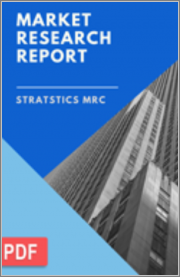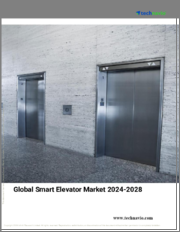
|
시장보고서
상품코드
1358991
세계의 스마트 엘리베이터 자동화 시스템 시장 예측(-2030년) : 서비스, 구성요소, 최종사용자 및 지역별 분석Smart Elevator Automation System Market Forecasts to 2030 - Global Analysis By Service (Repair & Maintenance Service, Modernization Service, Installation Service and Other Services), Component, End User and By Geography |
||||||
Stratistics MRC에 따르면, 세계 스마트 엘리베이터 자동화 시스템 시장은 2023년 208억 2,000만 달러로 예측 기간 동안 14.6%의 CAGR로 성장하여 2030년 540억 5,000만 달러에 달할 것으로 예상됩니다.
스마트 엘리베이터 자동화 시스템은 다양한 설비와 보안을 제공하는 차세대 제어 시스템입니다. 최첨단 기술이 탑재되어 있습니다. 최소한의 에너지 소비로 승객의 흐름을 효과적으로 관리합니다. 건물이나 시설 내 엘리베이터의 효율성, 안전성, 이용객의 편의성을 향상시키기 위해 정교한 첨단 기술을 활용한 제어 및 관리 시스템을 말합니다. 이 시스템은 다양한 센서, 데이터 분석 및 연결 기술을 활용하여 승객의 편의성을 높이고, 엘리베이터 운행을 최적화하며, 에너지 사용량을 줄입니다.
유엔(UN)에 따르면 전 세계 인구의 약 55%가 도시에 거주하고 있으며, 2050년에는 전 세계 인구의 약 66%가 도시에 거주할 것으로 예상됩니다.
스마트시티에 대한 투자 증가
전 세계적으로 스마트시티 구상에 대한 투자가 증가하고 있는 것은 대도시권의 확장을 가져온 이민자 증가가 주요 요인입니다. 스마트시티는 도시 인구 증가로 인한 부담을 줄이기 위해 보다 혁신적인 솔루션을 제공할 수 있을 것으로 보입니다. 에너지 효율이 높은 도로망의 도입으로 효과적인 대중 교통 시스템을 구현할 수 있습니다. 스마트시티의 모멘텀이 증가하고 개발에 대한 막대한 투자가 예측 기간 동안 수요를 촉진할 것으로 예상됩니다.
기술적 문제
스마트 엘리베이터는 다른 기술과 마찬가지로 기술적 문제와 고장의 영향을 받기 쉽습니다. 이러한 문제는 승객에게 불편을 주거나 엘리베이터 서비스를 중단시킬 수 있으며, 신속한 유지보수가 필요합니다. 스마트 엘리베이터는 인터넷에 연결되어 있기 때문에 사이버 공격을 받을 수 있습니다. 엘리베이터가 제대로 보호되지 않으면 해커가 엘리베이터를 탈취할 수 있어 안전과 보안 모두에 위험을 초래할 수 있습니다. 이는 시장 확대를 가로막는 요소로 작용하고 있습니다.
IoT 솔루션으로 관리
엘리베이터는 오랜 시간 동안 탄소섬유로 만든 링크와 내구성이 뛰어난 기구를 사용하여 그 필요성을 유지하기 위해 만들어져 왔습니다. 사물인터넷은 현재 스마트 엘리베이터의 설계를 더욱 발전시키고 있으며, IoT의 결과로 엘리베이터는 더욱 기술적으로 발전하고 있습니다. 현재 IoT 지원 스마트 엘리베이터는 데이터 수집, 교통 흐름 추적, 심지어 강력한 광고 도구로 활용되고 있습니다. 이는 시장 성장을 촉진하는 요인이 되고 있습니다.
높은 투자비용
초기 단계의 막대한 투자 요구 사항은 어려운 점입니다. 기존 엘리베이터에 비해 설치, 자동화 및 보안 시스템 통합, 애프터 서비스, 적시 유지보수와 관련된 지출로 인해 엘리베이터의 전반적인 비용이 더 많이 듭니다. 프로젝트 자금 부족으로 인해 건설사들은 중층 건물과 아파트에 이러한 엘리베이터를 설치하는 데 어려움을 겪고 있습니다. 앞서 언급한 문제들로 인해 향후 몇 년 동안 시장은 완만하게 성장할 것으로 예상됩니다.
COVID-19의 영향:
COVID-19의 영향은 건설업계에 큰 타격을 입혔습니다. 전 세계적으로 봉쇄령이 내려진 이후 건물 개발이 보류되었습니다. 근로자들은 고향으로 돌아갔습니다. 스마트 엘리베이터 시장의 불확실한 경제와 신흥 경제 국가의 금융 위기로 인해 소비자들도 인프라 자산에 투자하는 것을 꺼려하고 있습니다. 그러나 유지보수 및 수리를 위한 스마트 엘리베이터의 사용은 계속 증가할 것으로 예상됩니다.
예측 기간 동안 보안 및 제어 시스템 부문이 가장 큰 비중을 차지할 것으로 예상
예측 기간 동안 보안 및 제어 시스템 분야가 가장 큰 시장으로 성장할 것으로 예상됨. 회생 제동 및 조명 제어는 에너지 사용과 지출을 줄이기 위해 각국의 기업들이 도입하고 있는 에너지 관리 도구 중 하나입니다. 이 시장 부문의 수익 증가는 주로 AI에 대한 막대한 투자와 엘리베이터 사용을 최적화하고 대기 시간을 줄이며 에너지 효율을 개선하기 위한 ML 모델 개발에 기인합니다.
예측 기간 동안 상업 부문이 가장 높은 CAGR을 기록할 것으로 예상
예측 기간 동안 가장 높은 CAGR을 기록할 것으로 예상되는 부문은 상업 부문입니다. 비지니스 빌딩의 현대화 서비스 요구는 일반적으로 에스컬레이터 및 엘리베이터 안전 규칙의 도입으로 인해 발생합니다. 엘리베이터의 제어 시스템 및 카는 리노베이션의 일환으로 업그레이드하거나 새로운 구성요소 및 기술로 교체할 수 있습니다. 엘리베이터의 수명을 연장하고, 에너지를 절약하고, 승객에게 편안하고 안전한 승차감을 보장하고, 사용 편의성을 향상시킬 수 있습니다.
가장 큰 점유율을 차지하는 지역
북미 지역은 이미 구축된 인프라와 초기 기술 도입으로 인해 예측 기간 동안 가장 큰 시장 점유율을 차지할 것으로 예상됩니다. 또한, 비상용 소형 에너지 배터리와 같은 에너지 절약형 기기 및 부품에 대한 수요가 증가하고 있습니다. 스마트 엘리베이터 생산 및 설치에 대한 지역 전체의 대규모 투자와 의료 시설의 고성능 엘리베이터 시스템에 대한 수요 증가는 시장 수익의 성장을 촉진하는 주요 요인입니다.
CAGR이 가장 높은 지역:
아시아태평양은 급속한 인프라 구축과 도시화 진행으로 인해 예측 기간 동안 가장 높은 CAGR을 유지할 것으로 예상됩니다. 목적지 선택 제어 등을 포함한 엘리베이터 제어 기술의 급속한 발전은 시장 참여자들에게 이익을 가져다 줄 수 있는 잠재력을 제공하고 있습니다. 다른 보급 요인으로는 운영 비용 절감을 위한 정부의 엄격한 규제 및 표준, 건물 내 노후화된 엘리베이터 교체, 최첨단 출입 통제 기술 등이 있습니다.
무료 맞춤형 서비스:
이 보고서를 구독하는 고객은 다음과 같은 무료 맞춤형 옵션 중 하나를 사용할 수 있습니다:
- 회사 프로필
- 추가 시장 기업의 종합적인 프로파일링(최대 3개사까지)
- 주요 기업 SWOT 분석(3개사까지)
- 지역 세분화
- 고객의 관심에 따른 주요 국가별 시장 추정 및 예측, CAGR(참고: 타당성 검토에 따른)
- 경쟁사 벤치마킹
- 제품 포트폴리오, 지리적 입지, 전략적 제휴를 기반으로 한 주요 기업 벤치마킹
목차
제1장 주요 요약
제2장 서문
- 개요
- 이해관계자
- 조사 범위
- 조사 방법
- 데이터 마이닝
- 데이터 분석
- 데이터 검증
- 조사 접근법
- 조사 소스
- 1차 조사 소스
- 2차 조사 소스
- 가정
제3장 시장 동향 분석
- 성장 촉진요인
- 성장 억제요인
- 기회
- 위협
- 최종사용자 분석
- 신흥 시장
- 신종 코로나바이러스 감염증(COVID-19)의 영향
제4장 Porter's Five Forces 분석
- 공급 기업의 교섭력
- 구매자의 교섭력
- 대체품의 위협
- 신규 참여업체의 위협
- 경쟁 기업 간의 경쟁 관계
제5장 세계의 스마트 엘리베이터 자동화 시스템 시장 : 서비스별
- 수리·유지보수 서비스
- 현대화 서비스
- 설치 서비스
- 기타 서비스
제6장 세계의 스마트 엘리베이터 자동화 시스템 시장 : 컴포넌트별
- 보안과 제어 시스템
- 생체인식
- 건물 관리 시스템
- 터치스크린과 키패드
- 센서, 모터, 자동화 시스템
- 카드 판독 장비
- 기타 컴포넌트
제7장 세계의 스마트 엘리베이터 자동화 시스템 시장 : 최종사용자별
- 주택
- 상업
- 산업
- 공익 공공시설
- 기타 최종사용자
제8장 세계의 스마트 엘리베이터 자동화 시스템 시장 : 지역별
- 북미
- 미국
- 캐나다
- 멕시코
- 유럽
- 독일
- 영국
- 이탈리아
- 프랑스
- 스페인
- 기타 유럽
- 아시아태평양
- 일본
- 중국
- 인도
- 호주
- 뉴질랜드
- 한국
- 기타 아시아태평양
- 남미
- 아르헨티나
- 브라질
- 칠레
- 기타 남미
- 중동 및 아프리카
- 사우디아라비아
- 아랍에미리트
- 카타르
- 남아프리카공화국
- 기타 중동 및 아프리카
제9장 주요 발전
- 계약, 파트너십, 협업, 합작투자
- 인수와 합병
- 신제품 발매
- 사업 확대
- 기타 주요 전략
제10장 기업 개요
- Tyco International Limited
- Hitachi Ltd.
- Kone Corporation
- Fujitec Co. Ltd.
- Otis Elevator Company
- ThyssenKrupp Elevator AG
- Schindler Group
- Mitsubishi Electric Corporation
- Honeywell International Inc.
- Johnson Controls Inc.
- ThyssenKrupp Elevator Technology
- Bosch Security Systems
- Toshiba Elevator and Building Systems Corporation
- Sigma Elevator Company
- Huawei Technologies Co., Ltd.
According to Stratistics MRC, the Global Smart Elevator Automation System Market is accounted for $20.82 billion in 2023 and is expected to reach $54.05 billion by 2030 growing at a CAGR of 14.6% during the forecast period. The smart elevator automation system is a new generation of control system that offers various facilities and security. It is outfitted with cutting-edge technologies. It is made to effectively manage passenger flow while consuming the least amount of energy possible. In order to improve the effectiveness, safety, and user experience of elevators inside a building or facility, it alludes to a sophisticated and technologically cutting-edge control and management system. This system makes use of a variety of sensors, data analytics, and connection technologies to enhance passenger convenience, optimize elevator operations, and lower energy usage.
According to the United Nations (UN), it has estimated that approximately 55% of the world's population lived in urban areas. By 2050, approximately 66% of the world's population is anticipated to reside in urban areas.
Market Dynamics:
Driver:
Increasing investments in smart cities
The growing investment in smart city initiatives around the world is mostly driven by increased migration, which has resulted in the ongoing expansion of metropolitan areas. Smart cities will offer more innovative solutions that can be used to ease the burden brought on by the expansion of the urban population. The implementation of energy-efficient road networks will result in effective public transportation systems. The growing momentum of smart cities and significant investments in their development are expected to propel the demand during the forecast period.
Restraint:
Technical issues
Smart elevators are susceptible to technological problems and breakdowns, just like any other type of technology. These problems can cause passengers inconvenience and elevator service disruption, and they necessitate prompt maintenance. The internet-connected nature of smart elevators makes them potentially vulnerable to cyber attacks. Hackers might be able to take over the elevators if they aren't properly protected, posing a risk to both safety and security. These are the elements preventing the market from expanding.
Opportunity:
Management with IoT solutions
Lifts have created over the long haul to keep on with the need, using carbon fiber links and all the more durable apparatus to keep them moving. The Internet of Things has made smart elevator design even more advanced at the moment. Elevators are becoming more technologically advanced as a result of IoT. Nowadays, IoT-enabled smart elevators are used for data collection, traffic flow tracking, and even as powerful advertising tools. This is the factor propelling the growth of the market.
Threat:
High investment costs
The beginning stage's huge investment requirement is the difficult aspect. In comparison to traditional elevators, the cost of the elevators is higher overall due to expenditures associated with installation, integration of automation and security systems, after-sale services, and timely maintenance. Due to a lack of project finance, construction companies also struggle to install these elevators in mid-rise buildings or apartments. The market is anticipated to increase slowly in the upcoming years as a result of the aforementioned issue.
COVID-19 Impact:
The effects of COVID-19 have been catastrophic for the construction industry. Building development has been put on hold ever since lockdowns were implemented all throughout the world. People who work have gone back to their hometowns. Due to the uncertain economy and the developing financial crisis in the smart elevator market, consumers are also reluctant to invest in infrastructure properties. However, it's expected that the use of smart elevators for maintenance and repair will continue to grow.
The security and control system segment is expected to be the largest during the forecast period
The security and control system segment is expected to be the largest during the forecast period. Regenerative braking and lighting control are among the energy management tools that businesses operating in different nations are implementing to cut down on energy use and expenditures. The rise of this market segment's revenue is primarily being driven by significant investments in AI and the creation of ML models to optimize elevator usage, decrease wait times, and improve energy efficiency.
The commercial segment is expected to have the highest CAGR during the forecast period
The commercial segment is expected to have the highest CAGR during the forecast period. The need for modernization services in business buildings is typically driven by the implementation of safety rules for escalators and elevators. Elevator control systems and cabins can be upgraded or replaced with new components and technology as part of renovation. It extends the life of the elevator, conserves energy, guarantees a comfortable and secure ride for passengers, and boosts user friendliness.
Region with largest share:
North America is projected to hold the largest market share during the forecast period owing to already well-established infrastructure and early technology adopters. Additionally, they are supplying the increasing need for energy-saving gadgets and parts, including small-size energy batteries for emergencies. Significant investments in producing and installing smart elevators across the area, as well as rising demand for high-performance elevator systems in healthcare facilities, are the main factors propelling market revenue development.
Region with highest CAGR:
Asia Pacific is projected to hold the highest CAGR over the forecast period owing to rapid infrastructure development and increasing urbanization. The quick development of elevator control technologies, including destination selection control and others, offers profitable potential for market players. Other factors contributing to the penetration include strict government regulations and standards designed to reduce operational costs, replacing outdated elevators in buildings and cutting-edge access control technologies.
Key players in the market:
Some of the key players in Smart Elevator Automation System market include: Tyco International Limited, Hitachi Ltd., Kone Corporation, Fujitec Co. Ltd., Otis Elevator Company, ThyssenKrupp Elevator AG, Schindler Group, Mitsubishi Electric Corporation, Honeywell International Inc., Johnson Controls Inc., ThyssenKrupp Elevator Technology, Bosch Security Systems, Toshiba Elevator and Building Systems Corporation, Sigma Elevator Company and Huawei Technologies Co., Ltd.
Key Developments:
In August 2022, Otis and Sharry announced a global partnership with its pilot program bringing elevator access integration to a modern AAA class administrative building SmichOFF located in Prague, Czech Republic.
In June 2022, TK Elevator and Infosys announced a global strategic collaboration. The global seven-year collaboration is an extension of the successful modernization of TK Elevator's IT infrastructure in Europe and Africa.
In May 2022, KONE Elevators India, a wholly-owned subsidiary of KONE Corporation announced the installation of world's largest passenger lift, which can carry over 200 people at a go, at the Jio World Centre in the city.
Services Covered:
- Repair & Maintenance Service
- Modernization Service
- Installation Service
- Other Services
Components Covered:
- Security and Control System
- Biometric
- Building Management System
- Touch Screen and Keypad
- Sensors, Motors and Automation System
- Card Reader
- Other Components
End Users Covered:
- Residential
- Commercial
- Industrial
- Institutional
- Other End Users
Regions Covered:
- North America
- US
- Canada
- Mexico
- Europe
- Germany
- UK
- Italy
- France
- Spain
- Rest of Europe
- Asia Pacific
- Japan
- China
- India
- Australia
- New Zealand
- South Korea
- Rest of Asia Pacific
- South America
- Argentina
- Brazil
- Chile
- Rest of South America
- Middle East & Africa
- Saudi Arabia
- UAE
- Qatar
- South Africa
- Rest of Middle East & Africa
What our report offers:
- Market share assessments for the regional and country-level segments
- Strategic recommendations for the new entrants
- Covers Market data for the years 2021, 2022, 2023, 2026, and 2030
- Market Trends (Drivers, Constraints, Opportunities, Threats, Challenges, Investment Opportunities, and recommendations)
- Strategic recommendations in key business segments based on the market estimations
- Competitive landscaping mapping the key common trends
- Company profiling with detailed strategies, financials, and recent developments
- Supply chain trends mapping the latest technological advancements
Free Customization Offerings:
All the customers of this report will be entitled to receive one of the following free customization options:
- Company Profiling
- Comprehensive profiling of additional market players (up to 3)
- SWOT Analysis of key players (up to 3)
- Regional Segmentation
- Market estimations, Forecasts and CAGR of any prominent country as per the client's interest (Note: Depends on feasibility check)
- Competitive Benchmarking
- Benchmarking of key players based on product portfolio, geographical presence, and strategic alliances
Table of Contents
1 Executive Summary
2 Preface
- 2.1 Abstract
- 2.2 Stake Holders
- 2.3 Research Scope
- 2.4 Research Methodology
- 2.4.1 Data Mining
- 2.4.2 Data Analysis
- 2.4.3 Data Validation
- 2.4.4 Research Approach
- 2.5 Research Sources
- 2.5.1 Primary Research Sources
- 2.5.2 Secondary Research Sources
- 2.5.3 Assumptions
3 Market Trend Analysis
- 3.1 Introduction
- 3.2 Drivers
- 3.3 Restraints
- 3.4 Opportunities
- 3.5 Threats
- 3.6 End User Analysis
- 3.7 Emerging Markets
- 3.8 Impact of Covid-19
4 Porters Five Force Analysis
- 4.1 Bargaining power of suppliers
- 4.2 Bargaining power of buyers
- 4.3 Threat of substitutes
- 4.4 Threat of new entrants
- 4.5 Competitive rivalry
5 Global Smart Elevator Automation System Market, By Service
- 5.1 Introduction
- 5.2 Repair & Maintenance Service
- 5.3 Modernization Service
- 5.4 Installation Service
- 5.5 Other Services
6 Global Smart Elevator Automation System Market, By Component
- 6.1 Introduction
- 6.2 Security and Control System
- 6.3 Biometric
- 6.4 Building Management System
- 6.5 Touch Screen and Keypad
- 6.6 Sensors, Motors and Automation System
- 6.7 Card Reader
- 6.8 Other Components
7 Global Smart Elevator Automation System Market, By End User
- 7.1 Introduction
- 7.2 Residential
- 7.3 Commercial
- 7.4 Industrial
- 7.5 Institutional
- 7.6 Other End Users
8 Global Smart Elevator Automation System Market, By Geography
- 8.1 Introduction
- 8.2 North America
- 8.2.1 US
- 8.2.2 Canada
- 8.2.3 Mexico
- 8.3 Europe
- 8.3.1 Germany
- 8.3.2 UK
- 8.3.3 Italy
- 8.3.4 France
- 8.3.5 Spain
- 8.3.6 Rest of Europe
- 8.4 Asia Pacific
- 8.4.1 Japan
- 8.4.2 China
- 8.4.3 India
- 8.4.4 Australia
- 8.4.5 New Zealand
- 8.4.6 South Korea
- 8.4.7 Rest of Asia Pacific
- 8.5 South America
- 8.5.1 Argentina
- 8.5.2 Brazil
- 8.5.3 Chile
- 8.5.4 Rest of South America
- 8.6 Middle East & Africa
- 8.6.1 Saudi Arabia
- 8.6.2 UAE
- 8.6.3 Qatar
- 8.6.4 South Africa
- 8.6.5 Rest of Middle East & Africa
9 Key Developments
- 9.1 Agreements, Partnerships, Collaborations and Joint Ventures
- 9.2 Acquisitions & Mergers
- 9.3 New Product Launch
- 9.4 Expansions
- 9.5 Other Key Strategies
10 Company Profiling
- 10.1 Tyco International Limited
- 10.2 Hitachi Ltd.
- 10.3 Kone Corporation
- 10.4 Fujitec Co. Ltd.
- 10.5 Otis Elevator Company
- 10.6 ThyssenKrupp Elevator AG
- 10.7 Schindler Group
- 10.8 Mitsubishi Electric Corporation
- 10.9 Honeywell International Inc.
- 10.10 Johnson Controls Inc.
- 10.11 ThyssenKrupp Elevator Technology
- 10.12 Bosch Security Systems
- 10.13 Toshiba Elevator and Building Systems Corporation
- 10.14 Sigma Elevator Company
- 10.15 Huawei Technologies Co., Ltd.



















